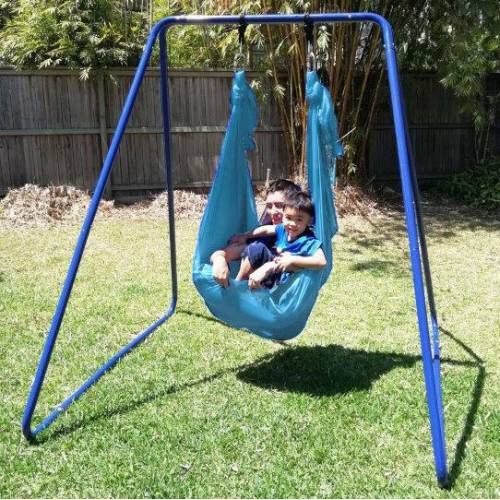I'll never forget the smile on my niece's face when we set up her very own sensory swing in our living room—it was like we brought the magic of the park right into our home.
Swinging isn't just for playgrounds anymore! Whether you're a parent looking to create a fun and calming space for your kids or you're interested in the sensory benefits of swinging for adults, installing a sensory swing at home can be a game-changer.
Here's your go-to guide to get that sensory swing up and swinging safely, whether you're aiming for a cozy corner indoors or a breezy setup outdoors.

Choosing the Right Space for Your Sensory Swing
Finding the perfect spot for your sensory swing is crucial. Indoors, you'll want a space where the swing can move freely without bumping into furniture or walls. High ceilings are a plus, as they provide ample room for swinging. Outdoors, look for a spot that's not only safe but also offers some shade to protect against the sun.
When we installed ours, we chose a spot in the playroom where the swing could hang from a central beam—this avoided any doorways and wasn't too close to the window.
Step-by-Step Guide to Installing a Sensory Swing Indoors
Tools You’ll Need:
- Drill
- Stud finder (crucial for finding those ceiling beams!)
- Screws and eye bolts appropriate for your ceiling material
- Wrench
- Level (to ensure your swing hangs evenly)

- Locate a Ceiling Joist: Use a stud finder to locate a joist in your chosen location. This is crucial as the joist will support the weight of the swing and its occupant.
- Mark and Drill: Once you’ve found your joist, mark the spot where you'll install the eye bolt. Drill a pilot hole slightly smaller than the width of your eye bolt.
- Install the Eye Bolt: Screw the eye bolt into the hole. You might need a wrench to fully tighten it, ensuring it's secure.
- Attach the Swing: Hook the swing onto the eye bolt, making sure it's securely fastened. Double-check all connections before the first use.
Essential Tools for Installing a Sensory Swing
Don't forget the basics! Alongside your drill and bolts, having a level is key to ensure your swing doesn’t tilt to one side. A good wrench set can also make the installation much smoother and faster.

Best Outdoor Setups for Sensory Swings
Outdoors, you have the freedom to get creative. Trees are a popular choice, but make sure you choose a sturdy branch and consider using a strap that won’t harm the tree bark. Alternatively, a solid, high-quality swing set frame can be a great investment if you lack suitable trees.
Tips for Securing Sensory Swings Safely
Safety first! Always check the weight limits on your hardware and swing. It’s a good practice to periodically check the integrity of the setup, especially if it’s used frequently or outdoors. Also, padding underneath the swing, like a soft play mat, can add an extra layer of safety for indoor setups.
Common Installation Mistakes and How to Avoid Them
One common mistake is underestimating the weight the swing needs to support. Always opt for hardware that can support at least twice the weight of the heaviest user. Another mistake is improper leveling during installation, which can cause uneven wear and tear or uncomfortable swinging.

Can You Install a Sensory Swing in an Apartment?
Absolutely! Just make sure to use a doorway swing support bar or wall-mounted brackets if ceiling installation isn’t an option. Be mindful of the noise and ensure it's securely installed to avoid damage.
Maintenance Tips for Long-lasting Sensory Swings
Regularly check all components for signs of wear and tear, especially if installed outdoors. Replace any worn-out parts immediately. Cleaning the swing according to the manufacturer's instructions is also key to maintaining its condition and ensuring safety.
Checking and Adjusting Your Sensory Swing for Safety
Before each use, give your swing a quick check. Make sure all connections are tight and the swing hangs evenly. Adjustments might be necessary over time, especially if the swing sees a lot of action or faces environmental stressors outdoors.
Installing a sensory swing can be a delightful project that brings joy and relaxation to your home. With the right tools, a bit of planning, and safety checks, you can install a sensory swing that is both fun and secure. Get ready to swing into relaxation like a pro!
Choosing the Best Sensory Swing for Your Needs
Selecting the right sensory swing can make a big difference. Siesta Hammocks offers a variety of sensory swings, including options that are weather-resistant, making them perfect for outdoor use, and others that are soft and comfortable, ideal for indoor relaxation. Some swings are specifically designed for children, while others can accommodate adults, providing therapeutic benefits for all ages.

Installation Services
If DIY isn't your thing, consider professional installation services. Companies like Siesta Hammocks often offer or recommend installation services, ensuring that your swing is set up safely and correctly. This can be particularly useful for those who are not handy or simply prefer to ensure that the installation meets all safety standards.
Maximizing the Benefits of Sensory Swings
Beyond just fun, sensory swings offer therapeutic benefits, particularly for those with sensory processing disorders. They can help improve coordination, balance, and sensory integration. By choosing the right type of swing and ensuring it is used regularly, you can maximize these benefits, making a significant positive impact on quality of life.
Adapting Swings for Different Spaces
Whether you're dealing with a compact apartment or a spacious backyard, there's a sensory swing setup for you. For smaller spaces, doorway swings or frame stands that don’t require ceiling installation can be ideal. In larger areas, you have the flexibility to opt for larger, more permanent installations.
By considering these additional factors and ensuring you have the right tools and knowledge, installing and enjoying a sensory swing can be a smooth and rewarding experience.

Comments